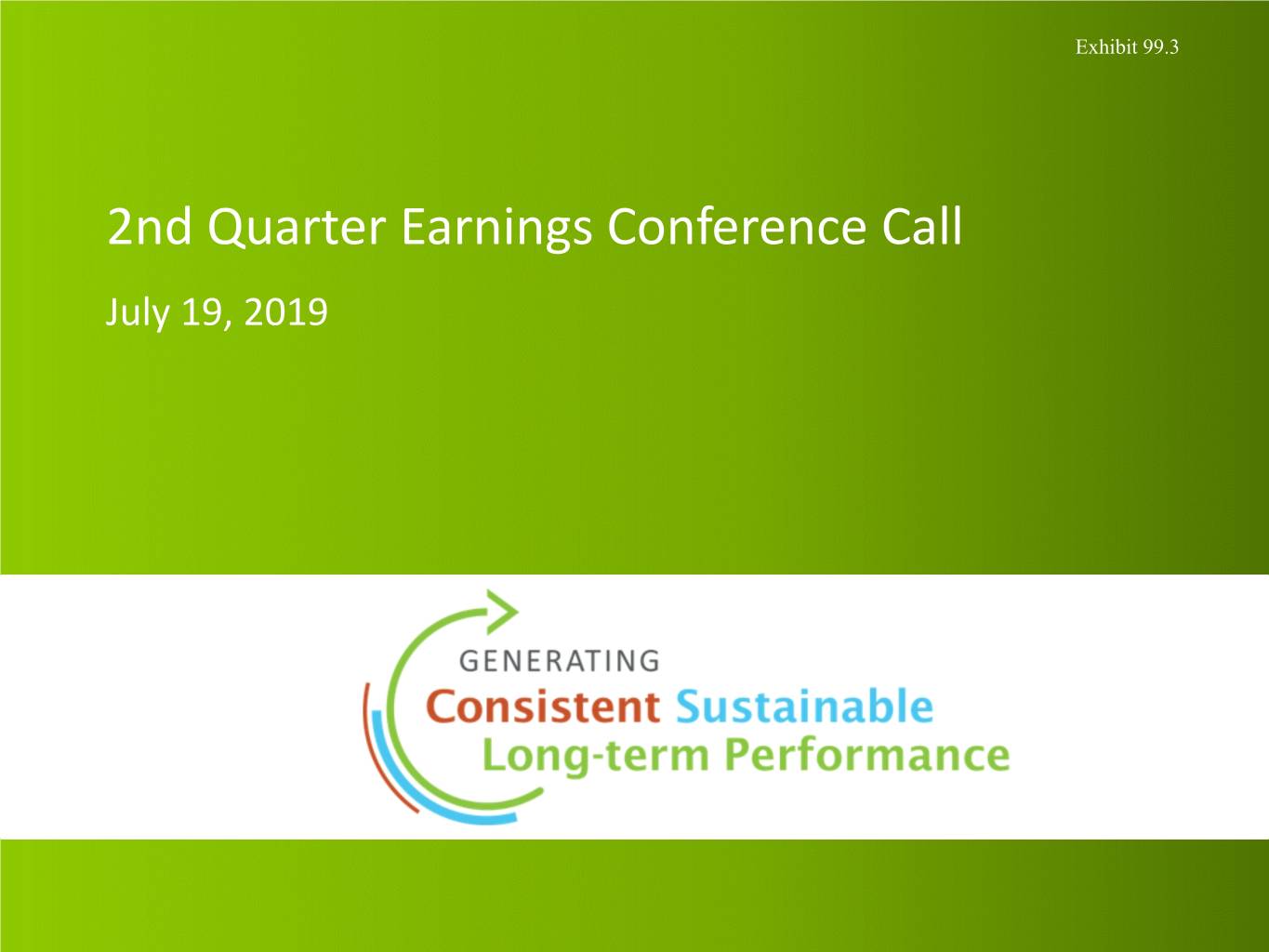
Exhibit 99.3 2nd Quarter Earnings Conference Call July 19, 2019
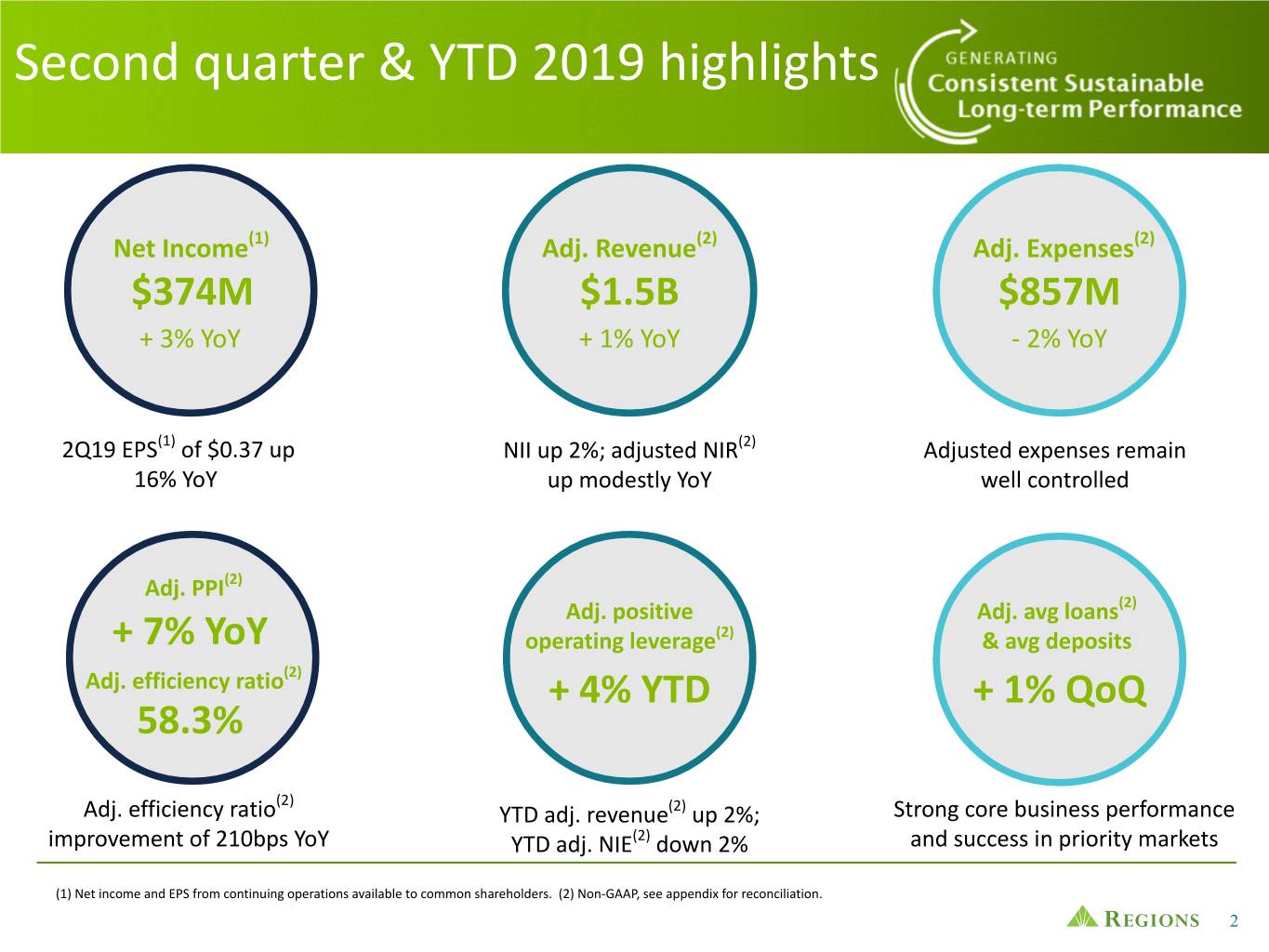
Second quarter & YTD 2019 highlights Net Income(1) Adj. Revenue(2) Adj. Expenses(2) $374M $1.5B $857M + 3% YoY + 1% YoY - 2% YoY 2Q19 EPS(1) of $0.37 up NII up 2%; adjusted NIR(2) Adjusted expenses remain 16% YoY up modestly YoY well controlled Adj. PPI(2) Adj. positive Adj. avg loans(2) + 7% YoY operating leverage(2) & avg deposits Adj. efficiency ratio(2) + 4% YTD + 1% QoQ 58.3% (2) Adj. efficiency ratio YTD adj. revenue(2) up 2%; Strong core business performance improvement of 210bps YoY YTD adj. NIE(2) down 2% and success in priority markets (1) Net income and EPS from continuing operations available to common shareholders. (2) Non-GAAP, see appendix for reconciliation. 2

Continued balance sheet optimization Loans and securities Average loans and leases Ending securities(2) ($ in billions) ($ in billions) $80.8 $81.3 $76.9 $24.5 $25.3 $24.1 28.3 28.2 27.9 49.0 52.5 53.1 06/30/18 03/31/19 06/30/19 2Q18 1Q19 2Q19 Adjusted business loans (1) Adjusted consumer loans (1) • Reduced securities portfolio book balance $1.5B through maturities and sales Balance sheet optimization: strategically • Repositioned another ~$2.8B improving positioning the balance sheet for maximum portfolio yield run rate 8bps; focus on efficiency to support net interest income and improving performance in a declining rate margin, as well as overall profitability. environment (1) Non-GAAP, see appendix for reconciliation. (2) Includes both AFS and HTM securities, as well as net unrealized gain (loss) on AFS securities. 3
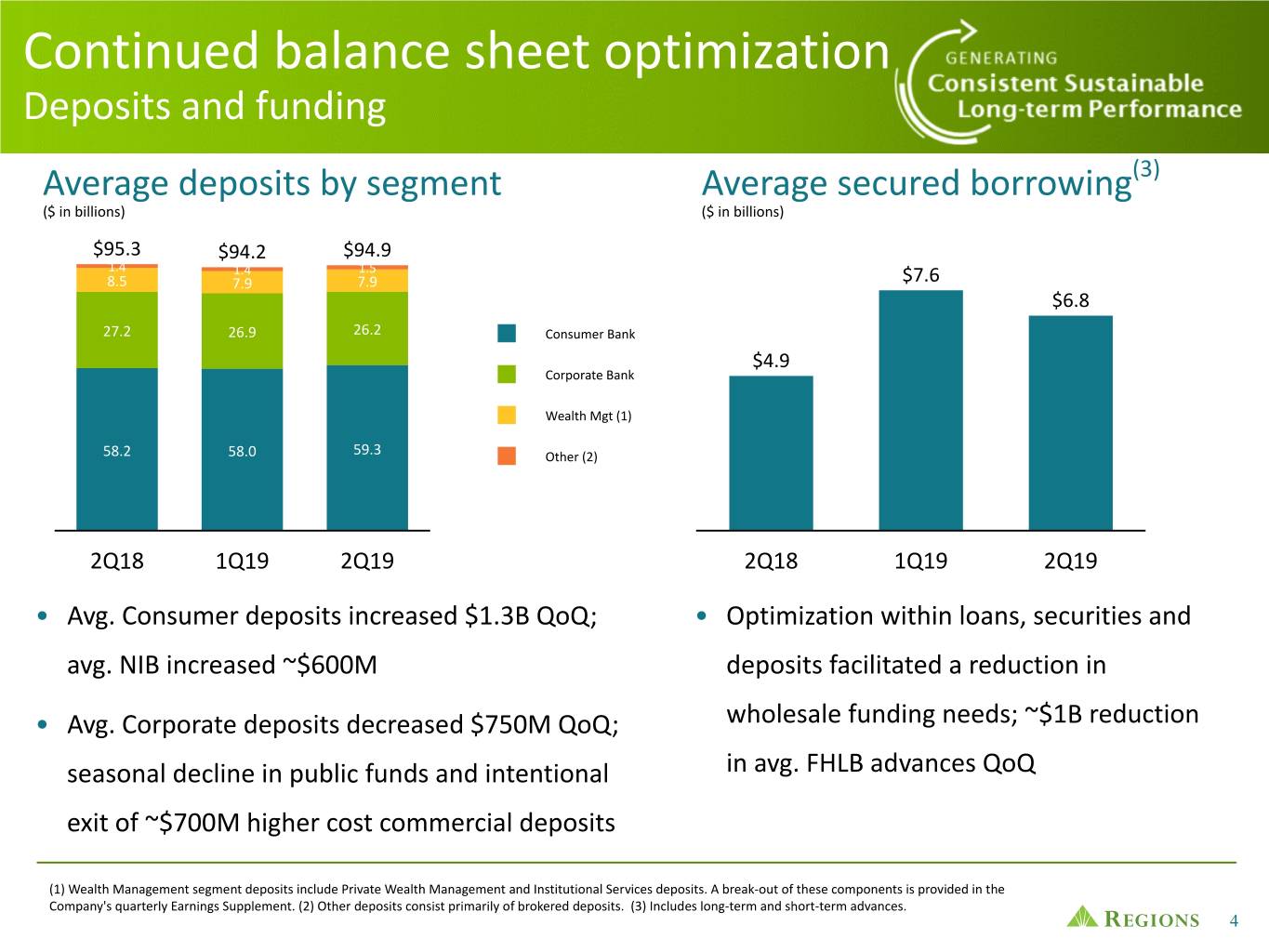
Continued balance sheet optimization Deposits and funding Average deposits by segment Average secured borrowing(3) ($ in billions) ($ in billions) $95.3 $94.2 $94.9 1.4 1.4 1.5 8.5 7.9 7.9 $7.6 $6.8 27.2 26.9 26.2 Consumer Bank $4.9 Corporate Bank Wealth Mgt (1) 58.2 58.0 59.3 Other (2) 2Q18 1Q19 2Q19 2Q18 1Q19 2Q19 • Avg. Consumer deposits increased $1.3B QoQ; • Optimization within loans, securities and avg. NIB increased ~$600M deposits facilitated a reduction in • Avg. Corporate deposits decreased $750M QoQ; wholesale funding needs; ~$1B reduction seasonal decline in public funds and intentional in avg. FHLB advances QoQ exit of ~$700M higher cost commercial deposits (1) Wealth Management segment deposits include Private Wealth Management and Institutional Services deposits. A break-out of these components is provided in the Company's quarterly Earnings Supplement. (2) Other deposits consist primarily of brokered deposits. (3) Includes long-term and short-term advances. 4

Net interest income(1) and net interest margin NII(1) and NIM NIM drivers ($ in millions) NIM Driver $938 $961 $956 3.53% 1Q19 (0.04)% Higher deposit costs 3.53% 3.49% 3.45% (0.02)% Lower market interest rates* (0.02)% One additional day 3.45% 2Q19 * 1mo LIBOR -6bps, 10yr UST -31bps 2Q18 1Q19 2Q19 NII N(1)II(1) NIM Total deposit costs • Deposit costs peaked in May then trended down 0.54 ◦ 29% cumulative deposit beta, one of the 0.53 0.52 lowest in the industry (2) 0.48 • Based on 6/30/19 market forward rates , expect 0.49 4Q19 NIM to approach 3.40%, then expand to low- 0.43 to-mid 3.40's in 1Q20 as forward starting hedges n b r r y n a e a p a u J F M A M J begin; full-year 2019 NII would be up modestly (1) Net interest income and other financing income on a fully taxable equivalent basis. (2) Include roughly three 25bp Fed Funds rate reductions by year-end 2019 and a stable 10yr UST ~2.0%. 5
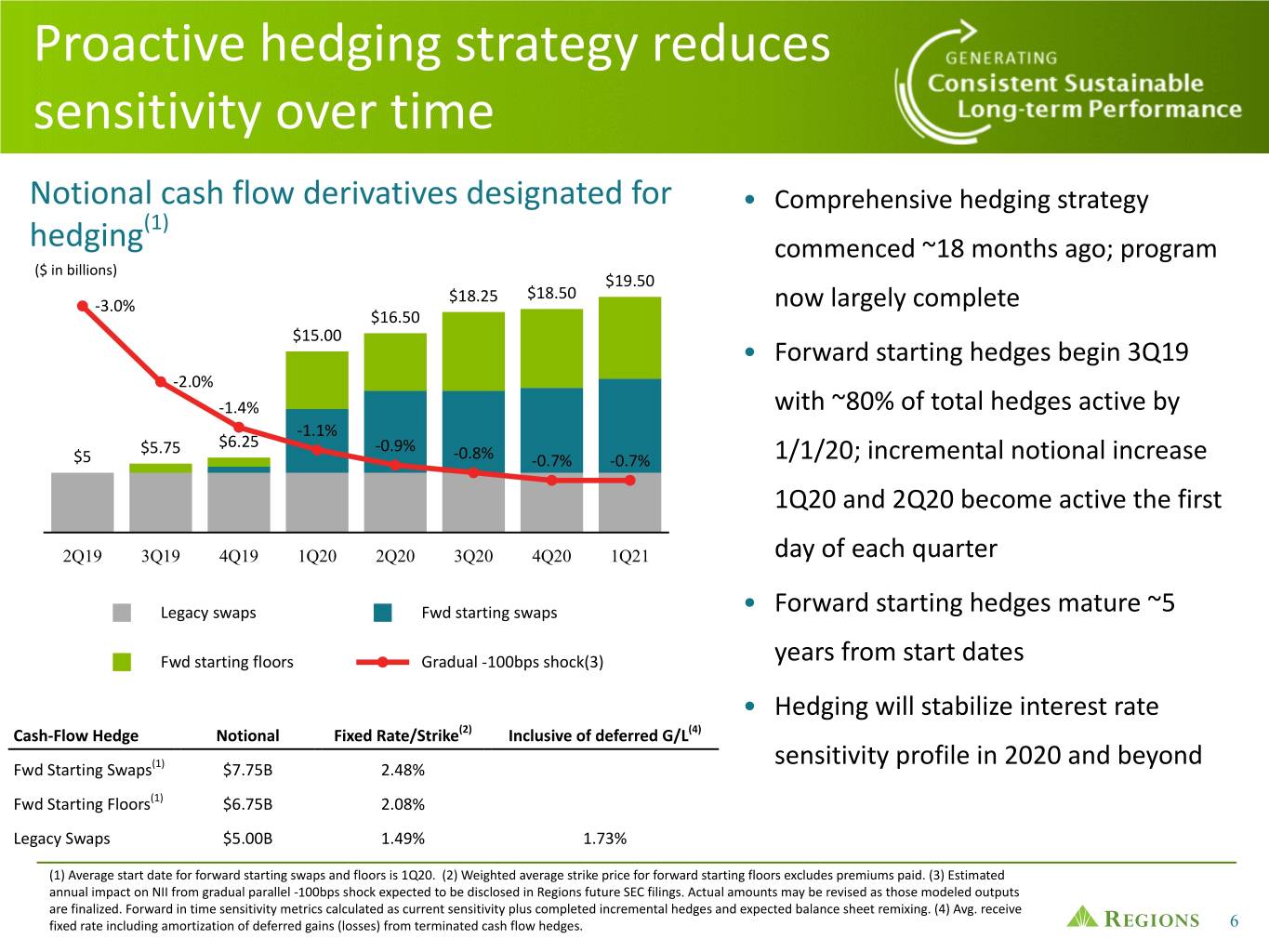
Proactive hedging strategy reduces sensitivity over time Notional cash flow derivatives designated for • Comprehensive hedging strategy (1) hedging commenced ~18 months ago; program ($ in billions) $19.50 $18.25 $18.50 -3.0% now largely complete $16.50 $15.00 • Forward starting hedges begin 3Q19 -2.0% -1.4% with ~80% of total hedges active by -1.1% $5.75 $6.25 -0.9% $5 -0.8% -0.7% -0.7% 1/1/20; incremental notional increase 1Q20 and 2Q20 become active the first 2Q19 3Q19 4Q19 1Q20 2Q20 3Q20 4Q20 1Q21 day of each quarter Legacy swaps Fwd starting swaps • Forward starting hedges mature ~5 Fwd starting floors Gradual -100bps shock(3) years from start dates • Hedging will stabilize interest rate Cash-Flow Hedge Notional Fixed Rate/Strike(2) Inclusive of deferred G/L(4) (1) sensitivity profile in 2020 and beyond Fwd Starting Swaps $7.75B 2.48% Fwd Starting Floors(1) $6.75B 2.08% Legacy Swaps $5.00B 1.49% 1.73% (1) Average start date for forward starting swaps and floors is 1Q20. (2) Weighted average strike price for forward starting floors excludes premiums paid. (3) Estimated annual impact on NII from gradual parallel -100bps shock expected to be disclosed in Regions future SEC filings. Actual amounts may be revised as those modeled outputs are finalized. Forward in time sensitivity metrics calculated as current sensitivity plus completed incremental hedges and expected balance sheet remixing. (4) Avg. receive fixed rate including amortization of deferred gains (losses) from terminated cash flow hedges. 6
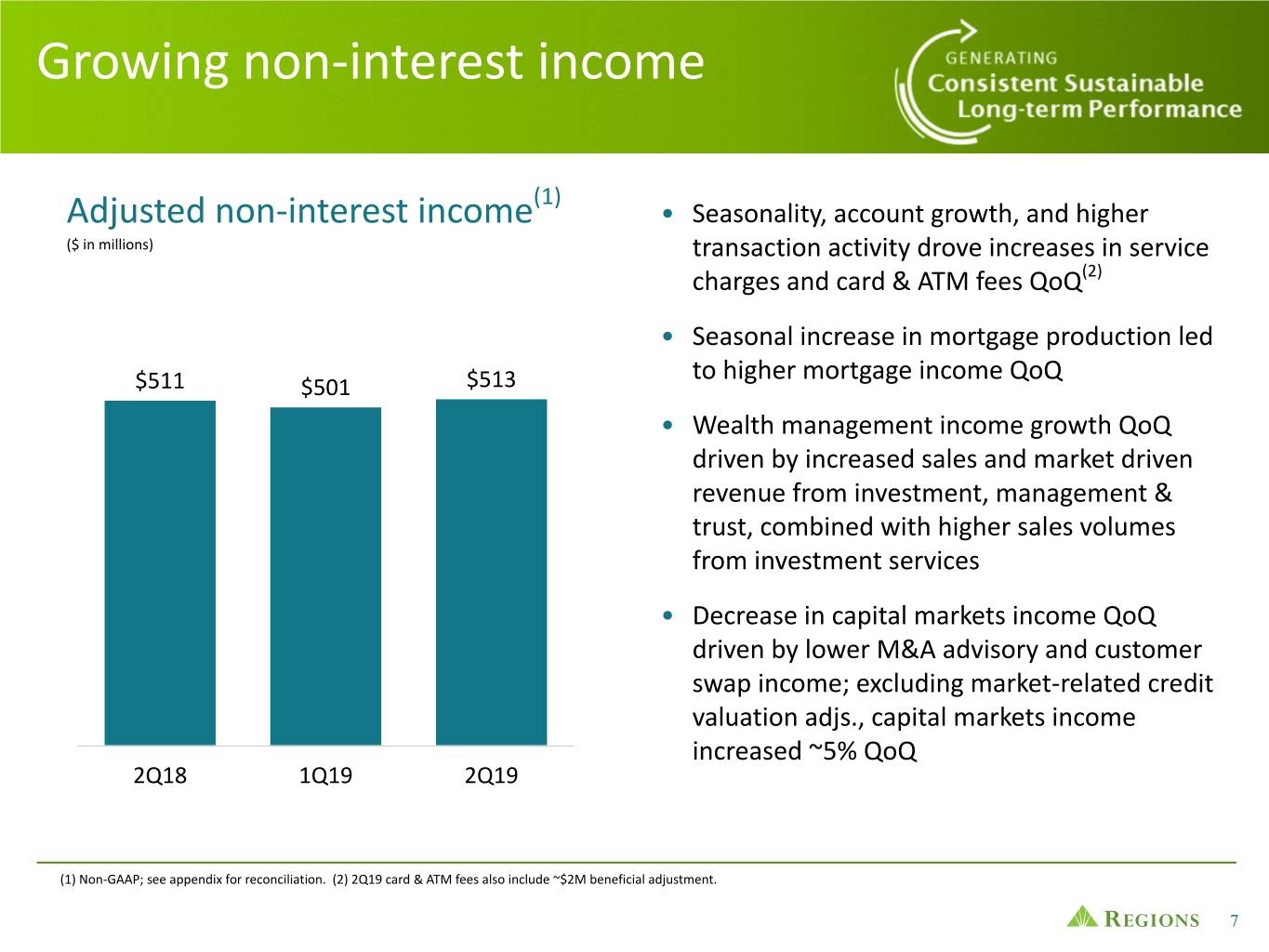
Growing non-interest income (1) Adjusted non-interest income • Seasonality, account growth, and higher ($ in millions) transaction activity drove increases in service charges and card & ATM fees QoQ(2) • Seasonal increase in mortgage production led to higher mortgage income QoQ $511 $501 $513 • Wealth management income growth QoQ driven by increased sales and market driven revenue from investment, management & trust, combined with higher sales volumes from investment services • Decrease in capital markets income QoQ driven by lower M&A advisory and customer swap income; excluding market-related credit valuation adjs., capital markets income increased ~5% QoQ 2Q18 1Q19 2Q19 (1) Non-GAAP; see appendix for reconciliation. (2) 2Q19 card & ATM fees also include ~$2M beneficial adjustment. 7
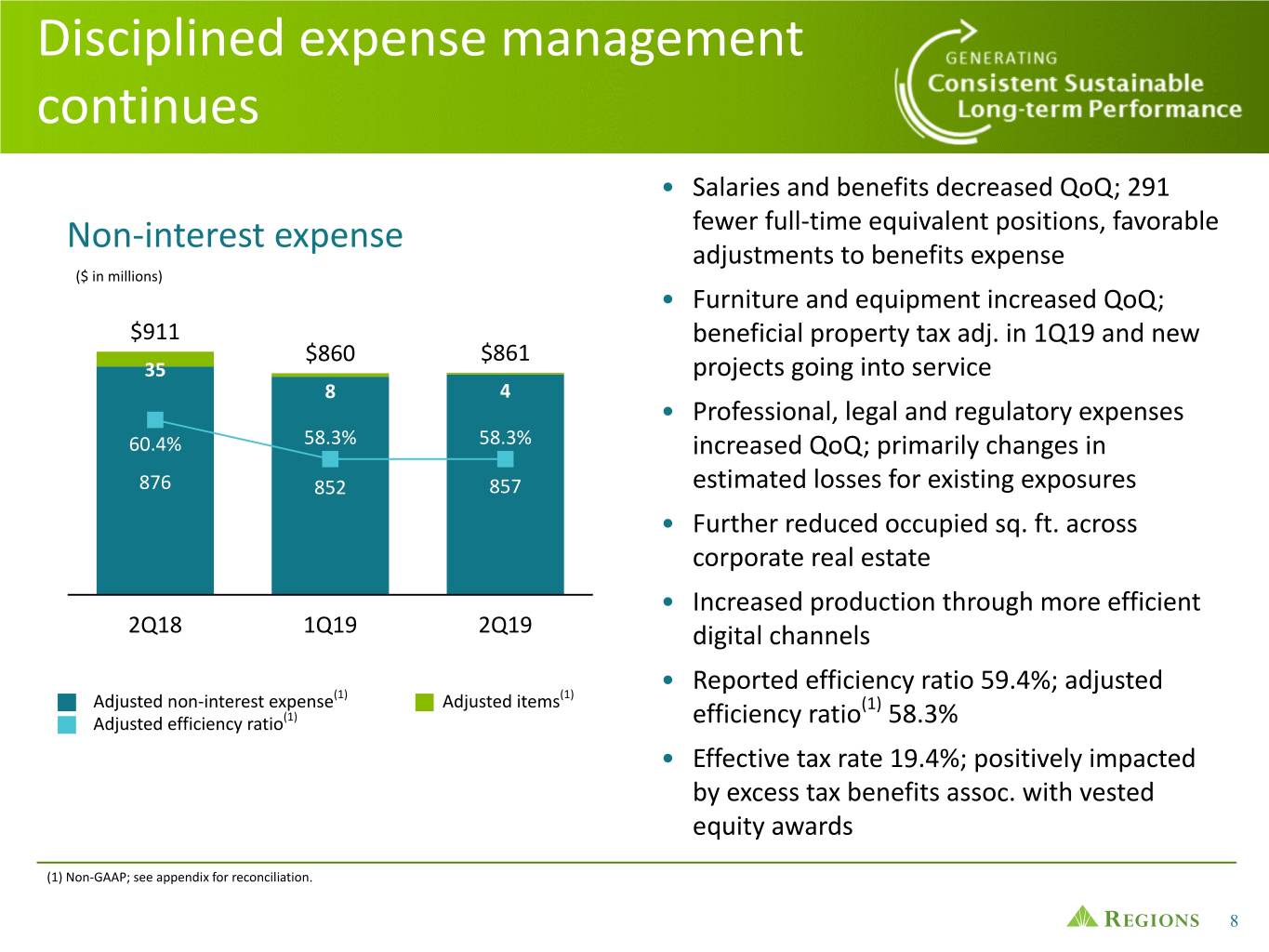
Disciplined expense management continues • Salaries and benefits decreased QoQ; 291 fewer full-time equivalent positions, favorable Non-interest expense adjustments to benefits expense ($ in millions) • Furniture and equipment increased QoQ; $911 beneficial property tax adj. in 1Q19 and new $860 $861 35 projects going into service 8 4 • Professional, legal and regulatory expenses 60.4% 58.3% 58.3% increased QoQ; primarily changes in 876 852 857 estimated losses for existing exposures • Further reduced occupied sq. ft. across corporate real estate • Increased production through more efficient 2Q18 1Q19 2Q19 digital channels (1) (1) • Reported efficiency ratio 59.4%; adjusted Adjusted non-interest expense Adjusted items (1) Adjusted efficiency ratio(1) efficiency ratio 58.3% • Effective tax rate 19.4%; positively impacted by excess tax benefits assoc. with vested equity awards (1) Non-GAAP; see appendix for reconciliation. 8
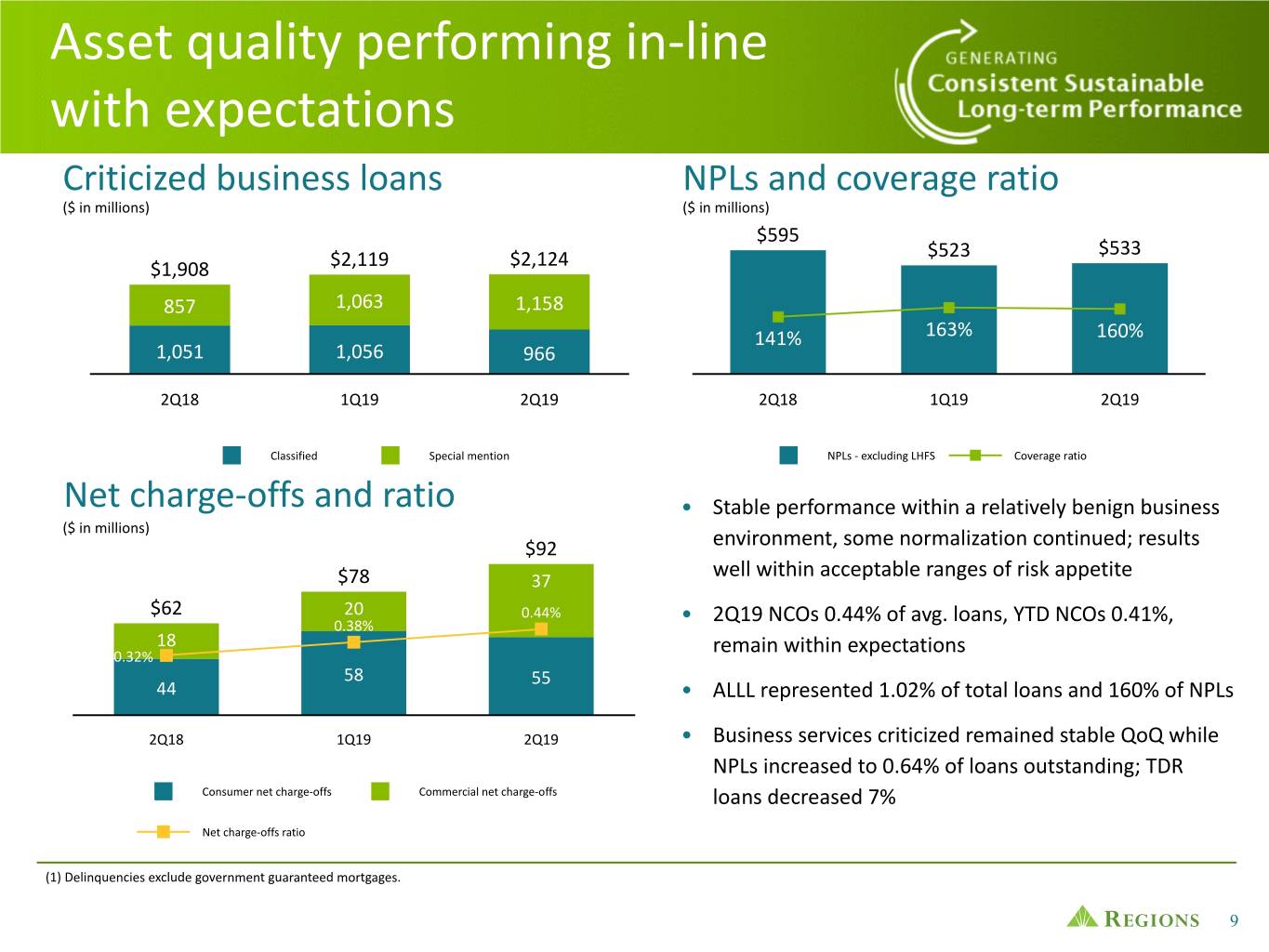
Asset quality performing in-line with expectations Criticized business loans NPLs and coverage ratio ($ in millions) ($ in millions) $595 $523 $533 $1,908 $2,119 $2,124 857 1,063 1,158 141% 163% 160% 1,051 1,056 53 966 2Q18 1Q19 2Q19 2Q18 1Q19 2Q19 Classified Special mention NPLs - excluding LHFS Coverage ratio Net charge-offs and ratio • Stable performance within a relatively benign business ($ in millions) $92 environment, some normalization continued; results well within acceptable ranges of risk appetite $78 37 $62 20 0.44% 0.38% • 2Q19 NCOs 0.44% of avg. loans, YTD NCOs 0.41%, 18 0.32% remain within expectations 58 55 44 • ALLL represented 1.02% of total loans and 160% of NPLs 2Q18 1Q19 2Q19 • Business services criticized remained stable QoQ while NPLs increased to 0.64% of loans outstanding; TDR Consumer net charge-offs Commercial net charge-offs loans decreased 7% Net charge-offs ratio (1) Delinquencies exclude government guaranteed mortgages. 9
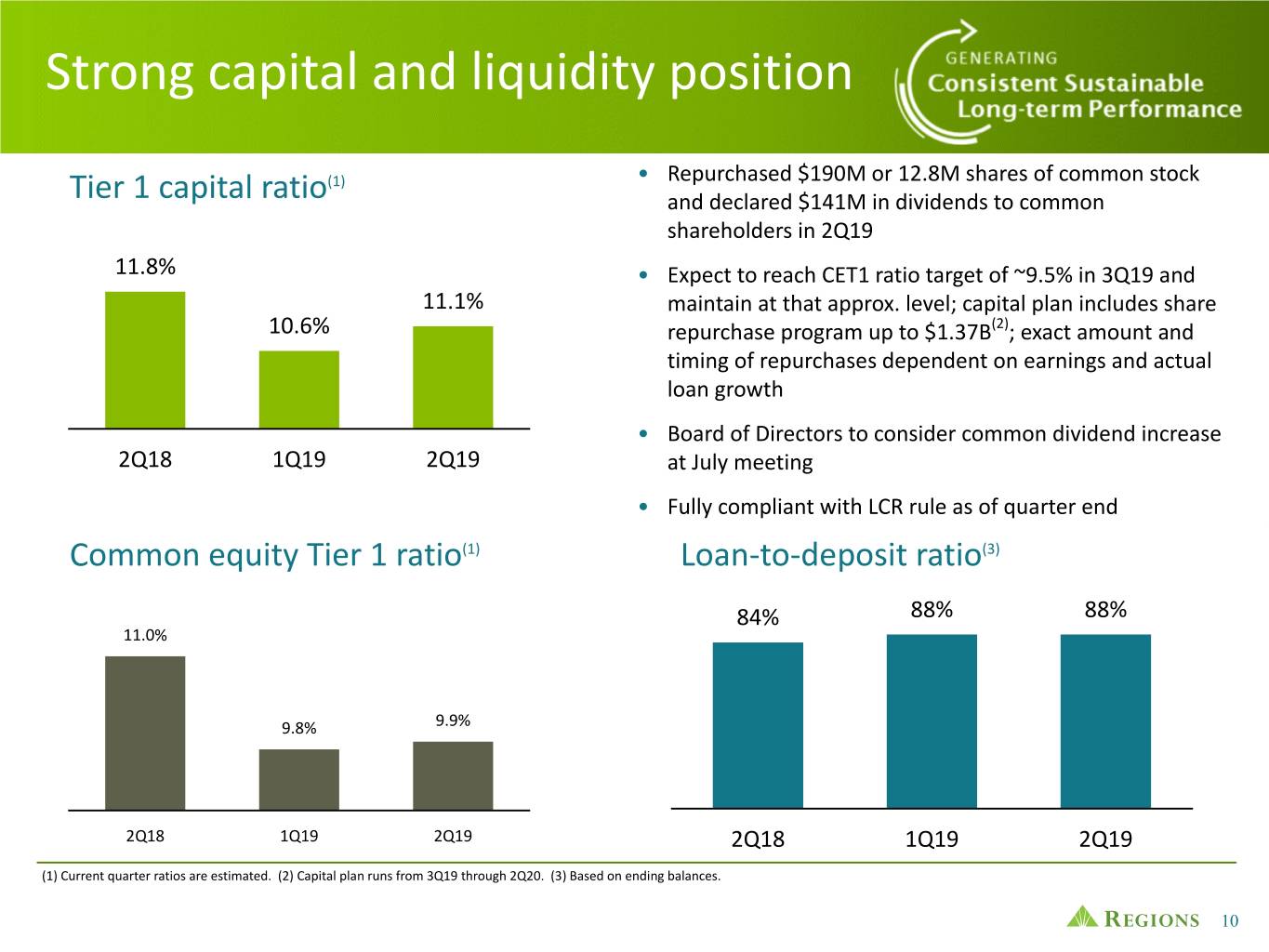
Strong capital and liquidity position (1) • Repurchased $190M or 12.8M shares of common stock Tier 1 capital ratio and declared $141M in dividends to common shareholders in 2Q19 11.8% • Expect to reach CET1 ratio target of ~9.5% in 3Q19 and 11.1% maintain at that approx. level; capital plan includes share 10.6% repurchase program up to $1.37B(2); exact amount and timing of repurchases dependent on earnings and actual loan growth • Board of Directors to consider common dividend increase 2Q18 1Q19 2Q19 at July meeting • Fully compliant with LCR rule as of quarter end Common equity Tier 1 ratio(1) Loan-to-deposit ratio(3) 84% 88% 88% 11.0% 9.8% 9.9% 2Q18 1Q19 2Q19 2Q18 1Q19 2Q19 (1) Current quarter ratios are estimated. (2) Capital plan runs from 3Q19 through 2Q20. (3) Based on ending balances. 10

Evolving near-term expectations 2019 Expectations Category FY 2019 Expectations Adjusted average loan growth (from adjusted 2018 of $77,667 million)(1) Low to mid-single digits Adjusted total revenue growth (from adjusted 2018 of $5,745 million)(1)(2) Lower end of 2% - 4% Adjusted non-interest expense (from adjusted 2018 of $3,434 million)(1)(2) Stable to down slightly Net charge-offs / average loans 40 - 50 bps Effective Tax Rate 20% - 22% Expect to generate adjusted positive operating leverage(1) 2019 base case assumes the June 30, 2019 market forward interest rate curve (includes roughly three Fed Funds rate reductions of 25bps in 2019), and a 10yr UST rate of ~2% (1) Non-GAAP, see appendix for reconciliation. The reconciliation with respect to forward-looking non-GAAP measures is expected to be consistent with actual non-GAAP reconciliations included in the attached appendix or previous filings with the SEC. (2) FY 2019 expectation was revised in 2Q19. 11
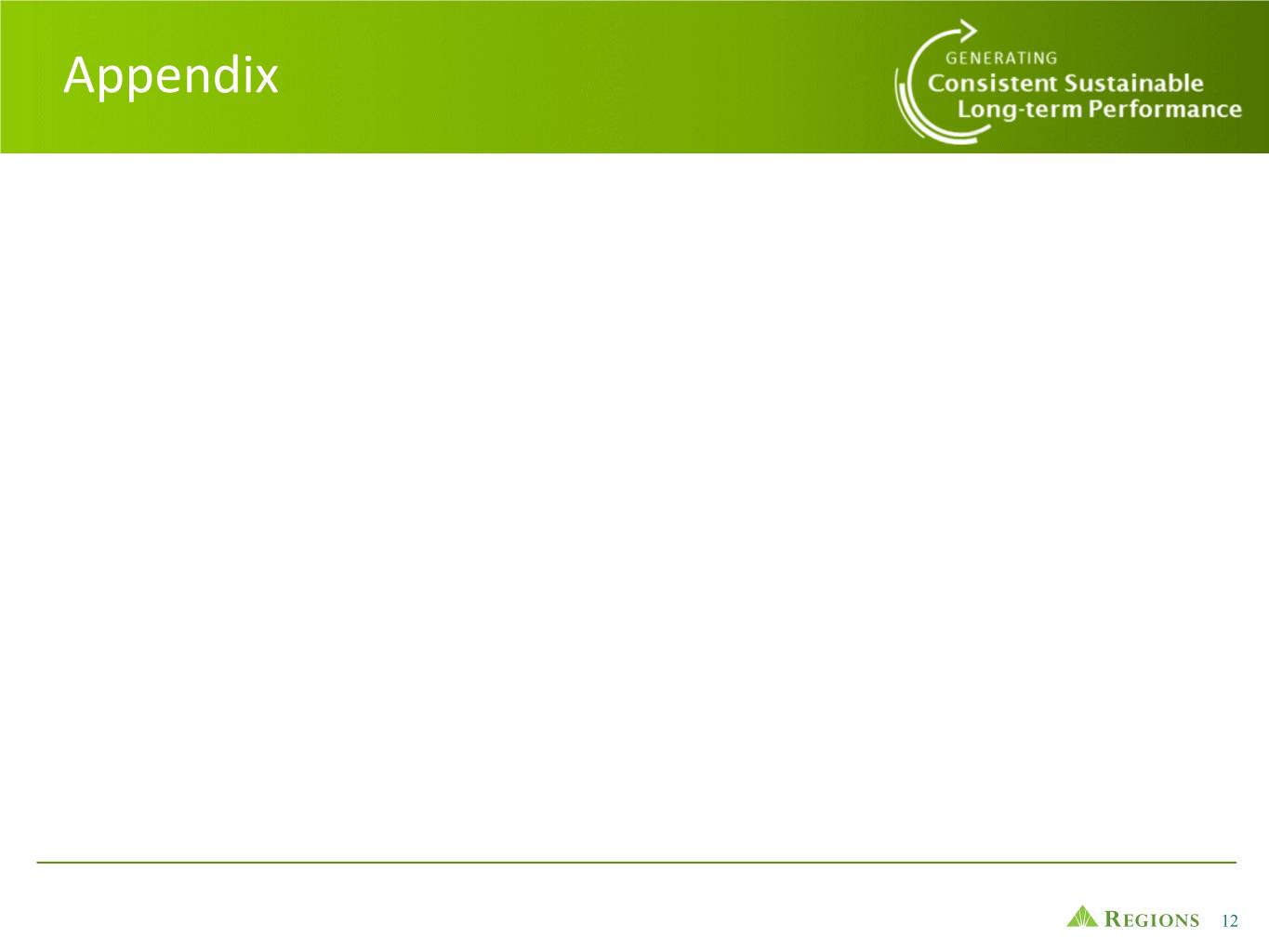
Appendix 12
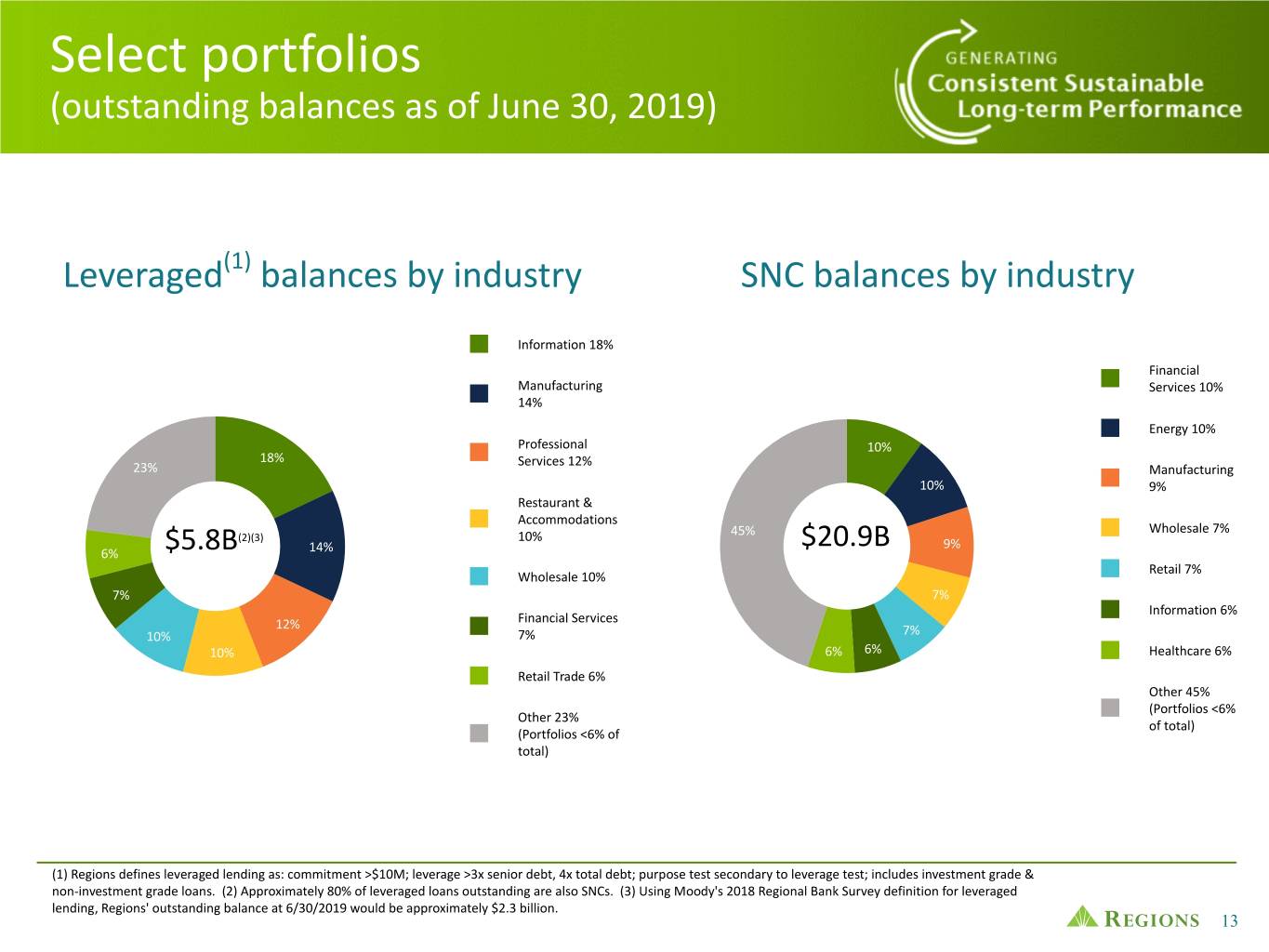
Select portfolios (outstanding balances as of June 30, 2019) Leveraged(1) balances by industry SNC balances by industry Information 18% Financial Manufacturing Services 10% 14% Energy 10% Professional 10% 18% Services 12% 23% Manufacturing 10% 9% Restaurant & Accommodations Wholesale 7% (2)(3) 10% 45% $20.9B 9% 6% $5.8B 14% Retail 7% Wholesale 10% 7% 7% Information 6% 12% Financial Services 10% 7% 7% 10% 6% 6% Healthcare 6% Retail Trade 6% Other 45% (Portfolios <6% Other 23% of total) (Portfolios <6% of total) (1) Regions defines leveraged lending as: commitment >$10M; leverage >3x senior debt, 4x total debt; purpose test secondary to leverage test; includes investment grade & non-investment grade loans. (2) Approximately 80% of leveraged loans outstanding are also SNCs. (3) Using Moody's 2018 Regional Bank Survey definition for leveraged lending, Regions' outstanding balance at 6/30/2019 would be approximately $2.3 billion. 13
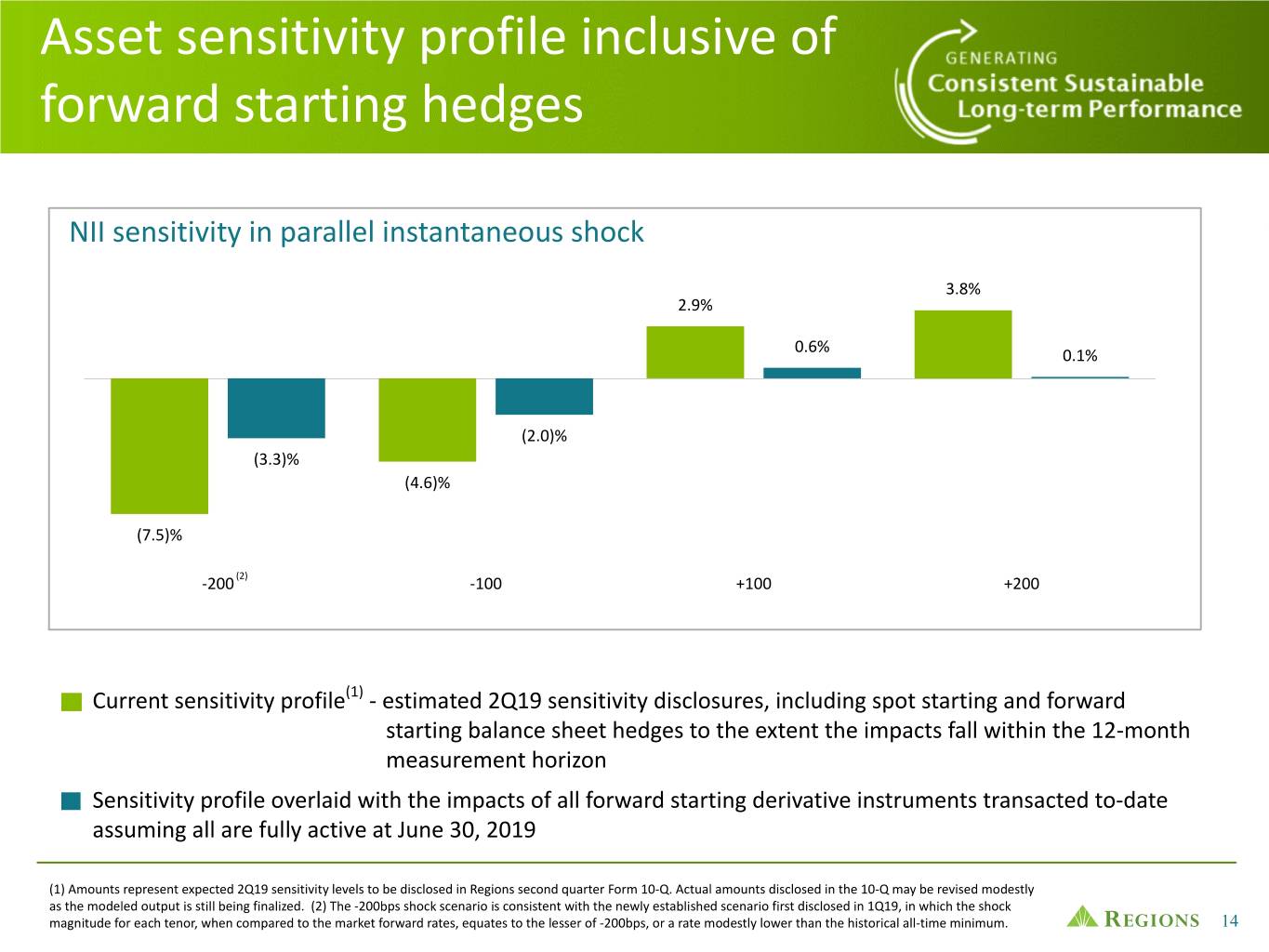
Asset sensitivity profile inclusive of forward starting hedges NII sensitivity in parallel instantaneous shock 3.8% 2.9% 0.6% 0.1% (2.0)% (3.3)% (4.6)% (7.5)% -200 (2) -100 +100 +200 Current sensitivity profile(1) - estimated 2Q19 sensitivity disclosures, including spot starting and forward starting balance sheet hedges to the extent the impacts fall within the 12-month measurement horizon Sensitivity profile overlaid with the impacts of all forward starting derivative instruments transacted to-date assuming all are fully active at June 30, 2019 (1) Amounts represent expected 2Q19 sensitivity levels to be disclosed in Regions second quarter Form 10-Q. Actual amounts disclosed in the 10-Q may be revised modestly as the modeled output is still being finalized. (2) The -200bps shock scenario is consistent with the newly established scenario first disclosed in 1Q19, in which the shock magnitude for each tenor, when compared to the market forward rates, equates to the lesser of -200bps, or a rate modestly lower than the historical all-time minimum. 14
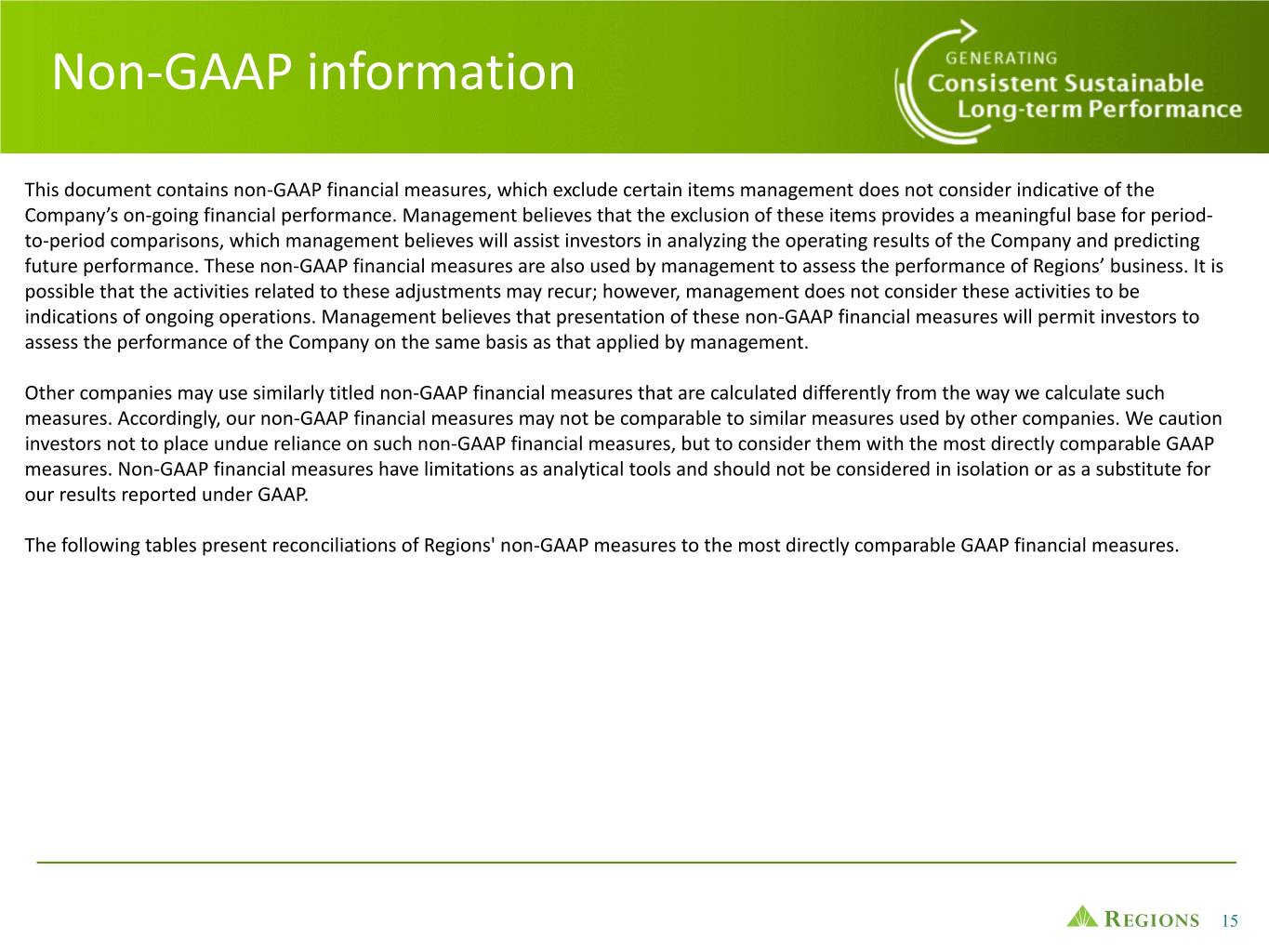
Non-GAAP information This document contains non-GAAP financial measures, which exclude certain items management does not consider indicative of the Company’s on-going financial performance. Management believes that the exclusion of these items provides a meaningful base for period- to-period comparisons, which management believes will assist investors in analyzing the operating results of the Company and predicting future performance. These non-GAAP financial measures are also used by management to assess the performance of Regions’ business. It is possible that the activities related to these adjustments may recur; however, management does not consider these activities to be indications of ongoing operations. Management believes that presentation of these non-GAAP financial measures will permit investors to assess the performance of the Company on the same basis as that applied by management. Other companies may use similarly titled non-GAAP financial measures that are calculated differently from the way we calculate such measures. Accordingly, our non-GAAP financial measures may not be comparable to similar measures used by other companies. We caution investors not to place undue reliance on such non-GAAP financial measures, but to consider them with the most directly comparable GAAP measures. Non-GAAP financial measures have limitations as analytical tools and should not be considered in isolation or as a substitute for our results reported under GAAP. The following tables present reconciliations of Regions' non-GAAP measures to the most directly comparable GAAP financial measures. 15
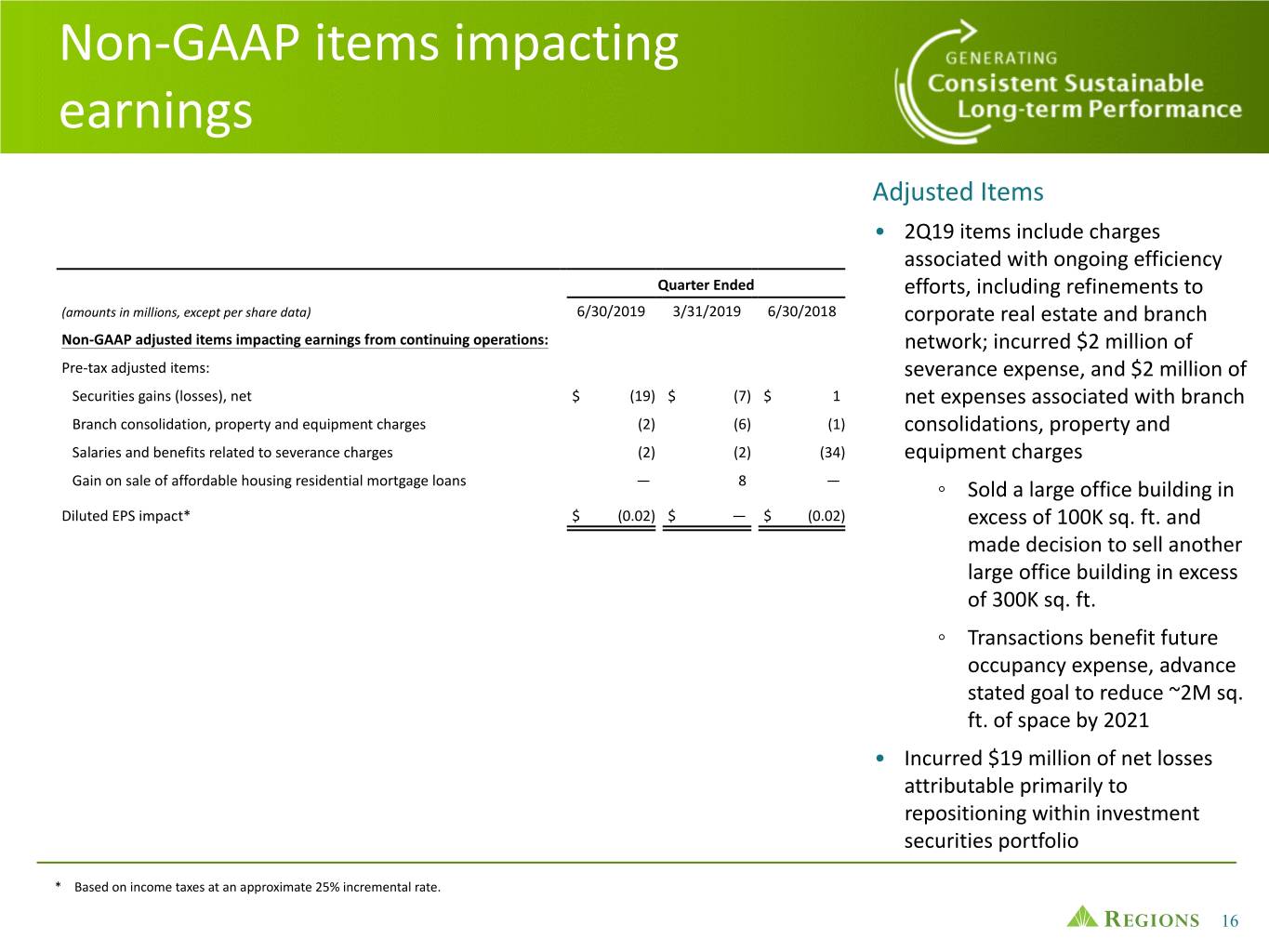
Non-GAAP items impacting earnings Adjusted Items • 2Q19 items include charges associated with ongoing efficiency Quarter Ended efforts, including refinements to (amounts in millions, except per share data) 6/30/2019 3/31/2019 6/30/2018 corporate real estate and branch Non-GAAP adjusted items impacting earnings from continuing operations: network; incurred $2 million of Pre-tax adjusted items: severance expense, and $2 million of Securities gains (losses), net $ (19) $ (7) $ 1 net expenses associated with branch Branch consolidation, property and equipment charges (2) (6) (1) consolidations, property and Salaries and benefits related to severance charges (2) (2) (34) equipment charges Gain on sale of affordable housing residential mortgage loans — 8 — ◦ Sold a large office building in Diluted EPS impact* $ (0.02) $ — $ (0.02) excess of 100K sq. ft. and made decision to sell another large office building in excess of 300K sq. ft. ◦ Transactions benefit future occupancy expense, advance stated goal to reduce ~2M sq. ft. of space by 2021 • Incurred $19 million of net losses attributable primarily to repositioning within investment securities portfolio * Based on income taxes at an approximate 25% incremental rate. 16

Non-GAAP reconciliation: adjusted average loans Average Balances ($ amounts in millions) 2Q19 1Q19 2Q18 2Q19 vs. 1Q19 2Q19 vs. 2Q18 Commercial and industrial $ 40,707 $ 39,999 $ 36,874 $ 708 1.8 % $ 3,833 10.4 % Add: Purchasing card balances (1) — — 228 — NM (228) (100.0)% Adjusted commercial and industrial loans (non-GAAP) $ 40,707 $ 39,999 $ 37,102 $ 708 1.8 % $ 3,605 9.7 % Total commercial loans $ 46,602 $ 45,968 $ 43,189 $ 634 1.4 % $ 3,413 7.9 % Add: Purchasing card balances (1) — — 228 — NM (228) (100.0)% Adjusted total commercial loans (non-GAAP) $ 46,602 $ 45,968 $ 43,417 $ 634 1.4 % $ 3,185 7.3 % Total business loans $ 53,098 $ 52,518 $ 48,780 $ 580 1.1 % $ 4,318 8.9 % Add: Purchasing card balances (1) — — 228 — NM (228) (100.0)% Adjusted total business loans (non-GAAP) $ 53,098 $ 52,518 $ 49,008 $ 580 1.1 % $ 4,090 8.3 % Total consumer loans $ 30,807 $ 31,476 $ 31,272 $ (669) (2.1)% $ (465) (1.5)% Less: Balances of residential first mortgage loans sold (2) — — — — NM — NM Less: Indirect—vehicles 2,578 2,924 3,260 (346) (11.8)% (682) (20.9)% Adjusted total consumer loans (non-GAAP) $ 28,229 $ 28,283 $ 27,917 $ (54) (0.2)% $ 312 1.1 % Total loans $ 83,905 $ 81,873 $ 79,891 $ 2,032 2.5 % $ 4,014 5.0 % Add: Purchasing card balances (1) — — 228 — NM (228) (100.0)% Less: Indirect—vehicles 2,578 2,924 3,260 (346) (11.8)% (682) (20.9)% Adjusted total loans (non-GAAP) $ 81,327 $ 80,801 $ 76,925 $ 526 0.7 % $ 4,402 5.7 % (1) On December 31, 2018, purchasing cards were reclassified to commercial and industrial loans from other assets. (2) Adjustments to average loan balances assume a simple day-weighted average impact for the first quarter of 2018. NM - Not Meaningful 17
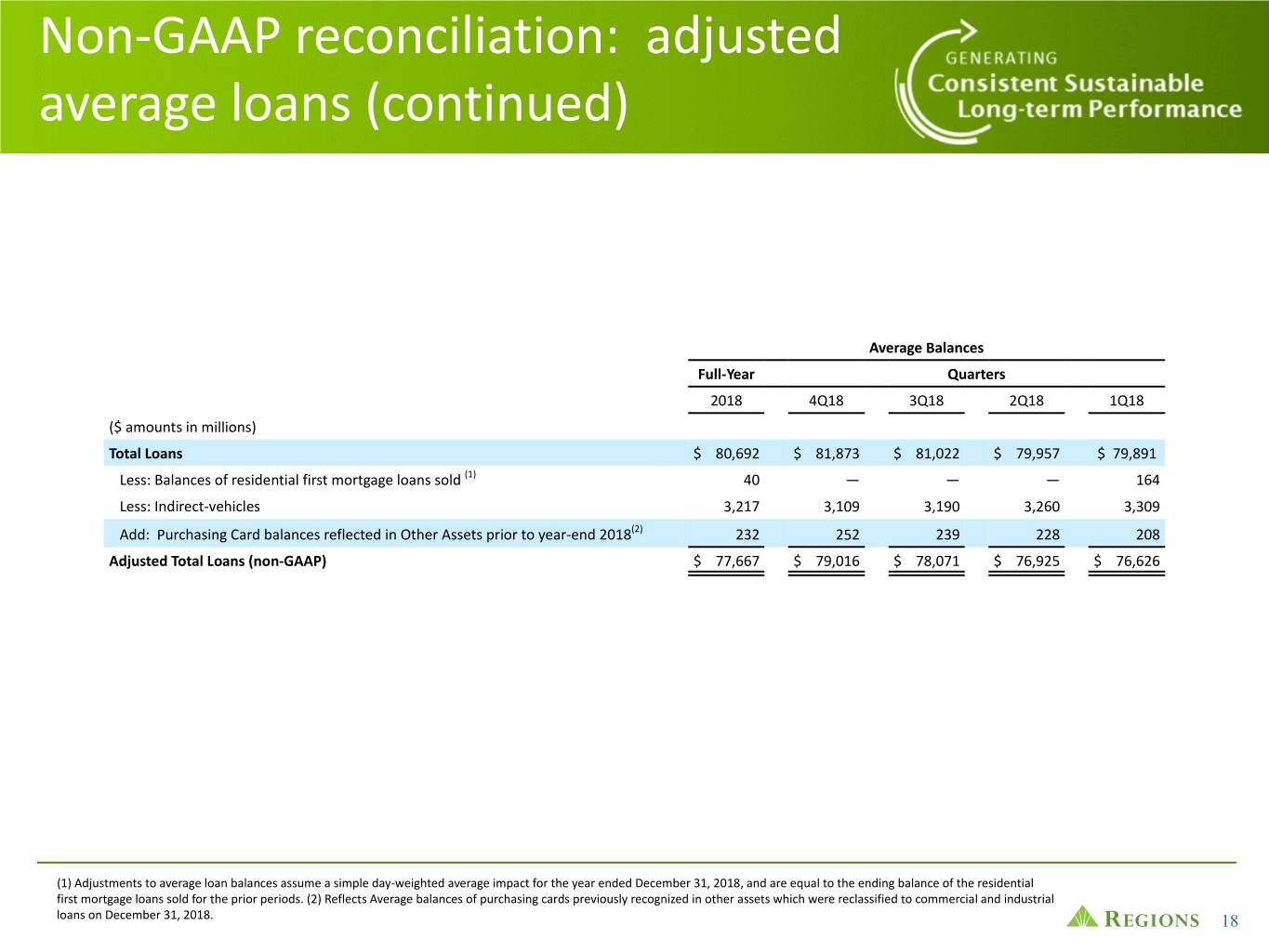
Non-GAAP reconciliation: adjusted average loans (continued) Average Balances Full-Year Quarters 2018 4Q18 3Q18 2Q18 1Q18 ($ amounts in millions) Total Loans $ 80,692 $ 81,873 $ 81,022 $ 79,957 $ 79,891 Less: Balances of residential first mortgage loans sold (1) 40 — — — 164 Less: Indirect-vehicles 3,217 3,109 3,190 3,260 3,309 Add: Purchasing Card balances reflected in Other Assets prior to year-end 2018(2) 232 252 239 228 208 Adjusted Total Loans (non-GAAP) $ 77,667 $ 79,016 $ 78,071 $ 76,925 $ 76,626 (1) Adjustments to average loan balances assume a simple day-weighted average impact for the year ended December 31, 2018, and are equal to the ending balance of the residential first mortgage loans sold for the prior periods. (2) Reflects Average balances of purchasing cards previously recognized in other assets which were reclassified to commercial and industrial loans on December 31, 2018. 18

Non-GAAP reconciliation: NII/NIM, non- interest income/expense, operating leverage and efficiency ratio Quarter Ended ($ amounts in millions) 6/30/2019 3/31/2019 6/30/2018 2Q19 vs. 1Q19 2Q19 vs. 2Q18 Non-interest expense (GAAP) A $ 861 $ 860 $ 911 $ 1 0.1 % $ (50) (5.5)% Adjustments: Branch consolidation, property and equipment charges (2) (6) (1) 4 (66.7)% (1) 100.0 % Salary and employee benefits—severance charges (2) (2) (34) — — % 32 (94.1)% Adjusted non-interest expense (non-GAAP) B $ 857 $ 852 $ 876 $ 5 0.6 % $ (19) (2.2)% Net interest income and other financing income (GAAP) C $ 942 $ 948 $ 926 $ (6) (0.6)% $ 16 1.7 % Taxable-equivalent adjustment 14 13 12 1 7.7 % 2 16.7 % Net interest income and other financing income, taxable-equivalent basis - continuing operations D $ 956 $ 961 $ 938 $ (5) (0.5)% $ 18 1.9 % Non-interest income (GAAP) E $ 494 $ 502 $ 512 $ (8) (1.6)% $ (18) (3.5)% Adjustments: Securities (gains) losses, net 19 7 (1) 12 171.4 % 20 NM Gain on sale of affordable housing residential mortgage loans — (8) — 8 (100.0)% — NM Adjusted non-interest income (non-GAAP) F $ 513 $ 501 $ 511 $ 12 2.4 % $ 2 0.4 % Total revenue C+E=G $ 1,436 $ 1,450 $ 1,438 $ (14) (1.0)% $ (2) (0.1)% Adjusted total revenue (non-GAAP) C+F=H $ 1,455 $ 1,449 $ 1,437 $ 6 0.4 % $ 18 1.3 % Total revenue, taxable-equivalent basis D+E=I $ 1,450 $ 1,463 $ 1,450 $ (13) (0.9)% $ — — % Adjusted total revenue, taxable-equivalent basis (non-GAAP) D+F=J $ 1,469 $ 1,462 $ 1,449 $ 7 0.5 % $ 20 1.4 % Efficiency ratio (GAAP) A/I 59.4% 58.8% 62.7% Adjusted efficiency ratio (non-GAAP) B/J 58.3% 58.3% 60.4% Fee income ratio (GAAP) E/I 34.1% 34.3% 35.3% Adjusted fee income ratio (non-GAAP) F/J 35.0% 34.3% 35.2% NM - Not Meaningful 19
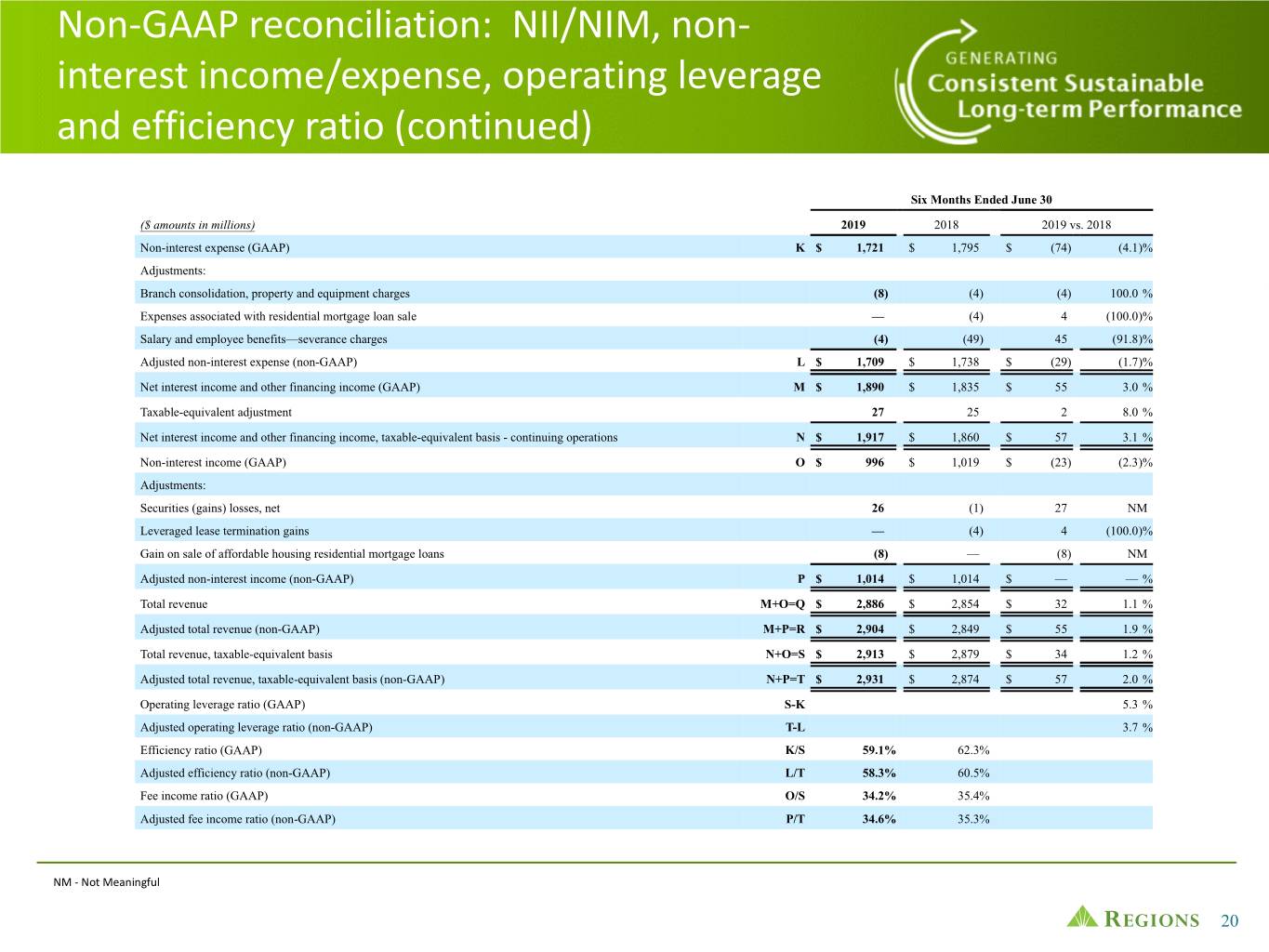
Non-GAAP reconciliation: NII/NIM, non- interest income/expense, operating leverage and efficiency ratio (continued) Six Months Ended June 30 ($ amounts in millions) 2019 2018 2019 vs. 2018 Non-interest expense (GAAP) K $ 1,721 $ 1,795 $ (74) (4.1)% Adjustments: Branch consolidation, property and equipment charges (8) (4) (4) 100.0 % Expenses associated with residential mortgage loan sale — (4) 4 (100.0)% Salary and employee benefits—severance charges (4) (49) 45 (91.8)% Adjusted non-interest expense (non-GAAP) L $ 1,709 $ 1,738 $ (29) (1.7)% Net interest income and other financing income (GAAP) M $ 1,890 $ 1,835 $ 55 3.0 % Taxable-equivalent adjustment 27 25 2 8.0 % Net interest income and other financing income, taxable-equivalent basis - continuing operations N $ 1,917 $ 1,860 $ 57 3.1 % Non-interest income (GAAP) O $ 996 $ 1,019 $ (23) (2.3)% Adjustments: Securities (gains) losses, net 26 (1) 27 NM Leveraged lease termination gains — (4) 4 (100.0)% Gain on sale of affordable housing residential mortgage loans (8) — (8) NM Adjusted non-interest income (non-GAAP) P $ 1,014 $ 1,014 $ — — % Total revenue M+O=Q $ 2,886 $ 2,854 $ 32 1.1 % Adjusted total revenue (non-GAAP) M+P=R $ 2,904 $ 2,849 $ 55 1.9 % Total revenue, taxable-equivalent basis N+O=S $ 2,913 $ 2,879 $ 34 1.2 % Adjusted total revenue, taxable-equivalent basis (non-GAAP) N+P=T $ 2,931 $ 2,874 $ 57 2.0 % Operating leverage ratio (GAAP) S-K 5.3 % Adjusted operating leverage ratio (non-GAAP) T-L 3.7 % Efficiency ratio (GAAP) K/S 59.1% 62.3% Adjusted efficiency ratio (non-GAAP) L/T 58.3% 60.5% Fee income ratio (GAAP) O/S 34.2% 35.4% Adjusted fee income ratio (non-GAAP) P/T 34.6% 35.3% NM - Not Meaningful 20
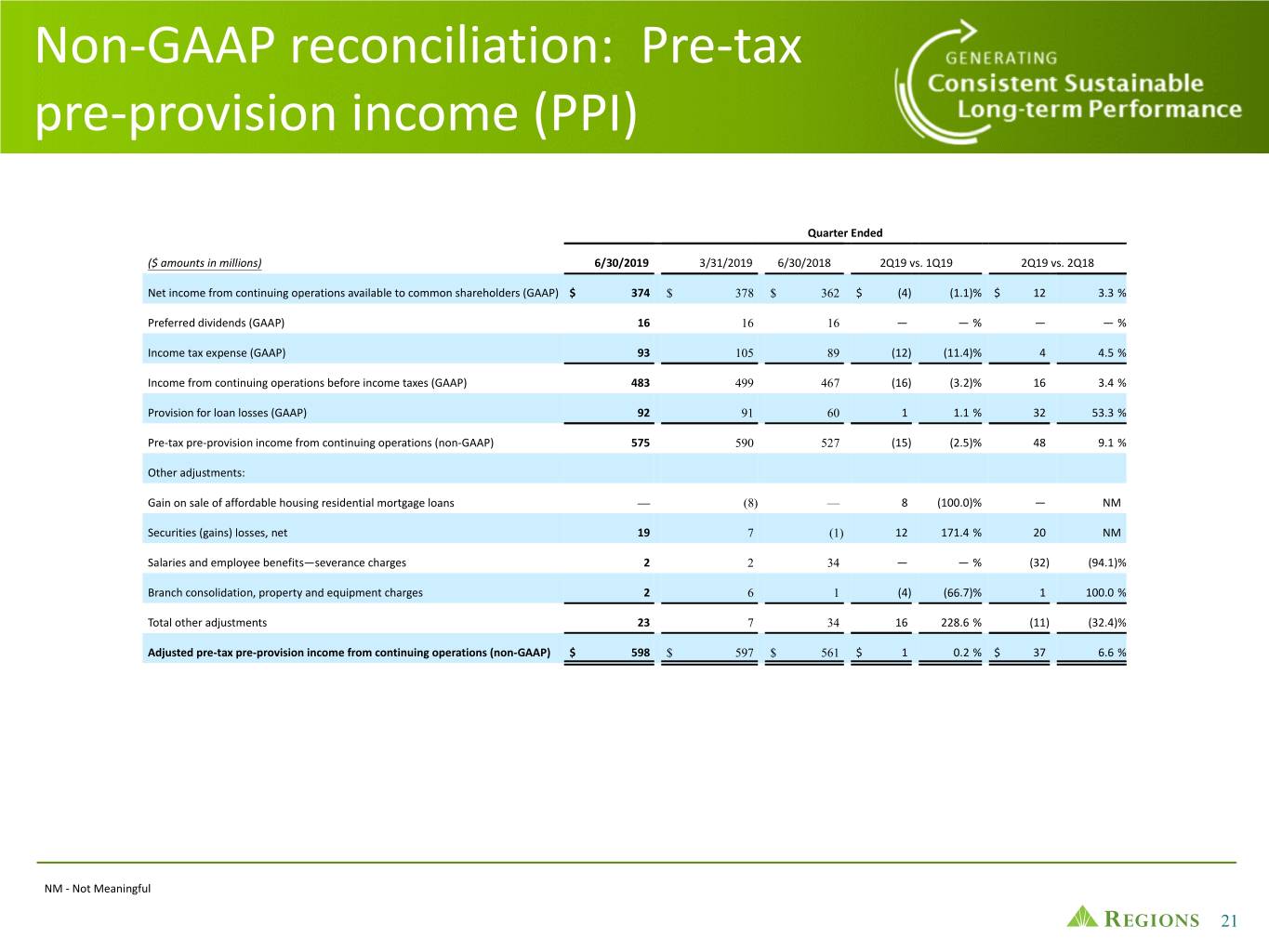
Non-GAAP reconciliation: Pre-tax pre-provision income (PPI) Quarter Ended ($ amounts in millions) 6/30/2019 3/31/2019 6/30/2018 2Q19 vs. 1Q19 2Q19 vs. 2Q18 Net income from continuing operations available to common shareholders (GAAP) $ 374 $ 378 $ 362 $ (4) (1.1)% $ 12 3.3 % Preferred dividends (GAAP) 16 16 16 — — % — — % Income tax expense (GAAP) 93 105 89 (12) (11.4)% 4 4.5 % Income from continuing operations before income taxes (GAAP) 483 499 467 (16) (3.2)% 16 3.4 % Provision for loan losses (GAAP) 92 91 60 1 1.1 % 32 53.3 % Pre-tax pre-provision income from continuing operations (non-GAAP) 575 590 527 (15) (2.5)% 48 9.1 % Other adjustments: Gain on sale of affordable housing residential mortgage loans — (8) — 8 (100.0)% — NM Securities (gains) losses, net 19 7 (1) 12 171.4 % 20 NM Salaries and employee benefits—severance charges 2 2 34 — — % (32) (94.1)% Branch consolidation, property and equipment charges 2 6 1 (4) (66.7)% 1 100.0 % Total other adjustments 23 7 34 16 228.6 % (11) (32.4)% Adjusted pre-tax pre-provision income from continuing operations (non-GAAP) $ 598 $ 597 $ 561 $ 1 0.2 % $ 37 6.6 % NM - Not Meaningful 21
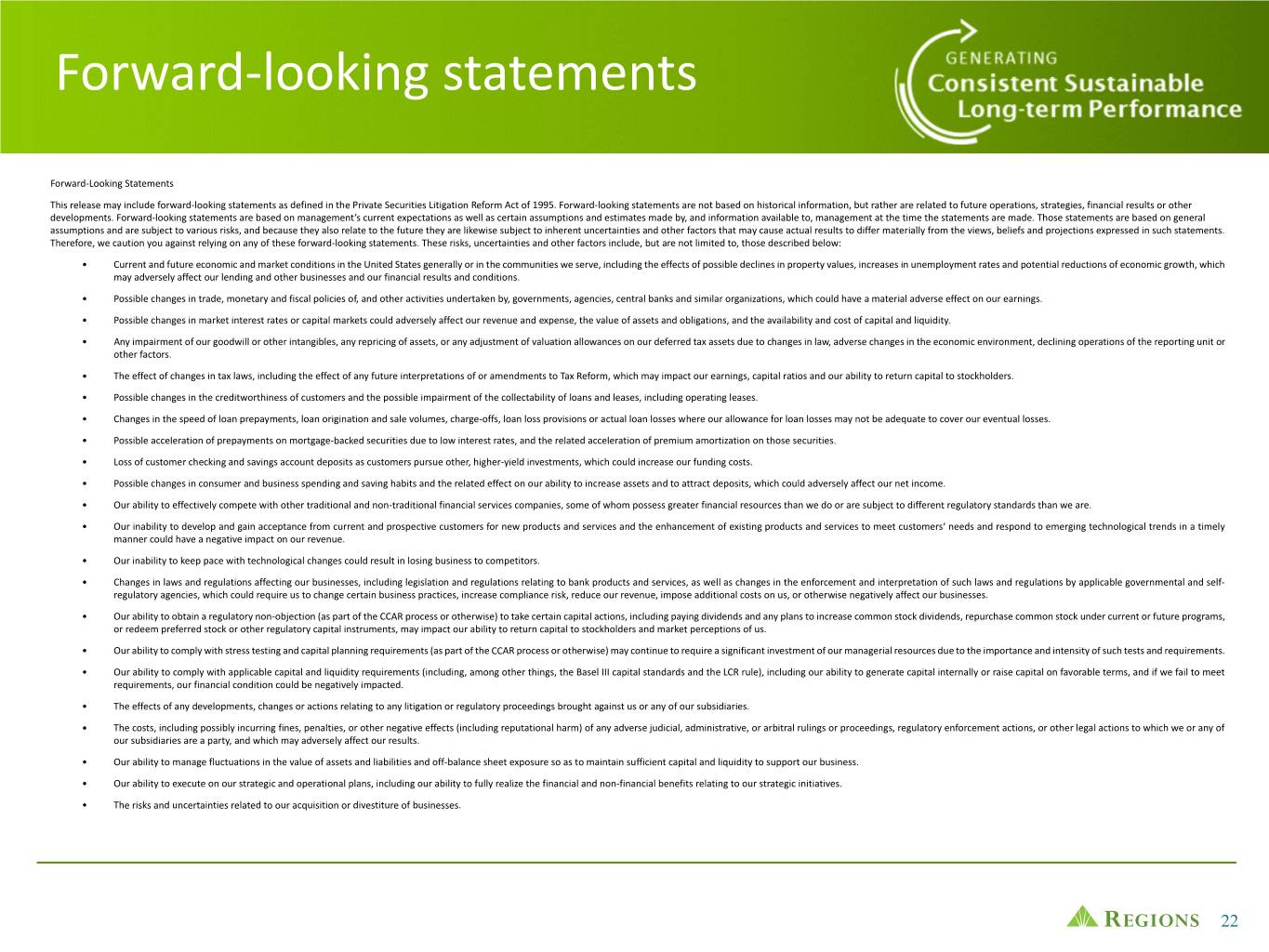
Forward-looking statements Forward-Looking Statements This release may include forward-looking statements as defined in the Private Securities Litigation Reform Act of 1995. Forward-looking statements are not based on historical information, but rather are related to future operations, strategies, financial results or other developments. Forward-looking statements are based on management’s current expectations as well as certain assumptions and estimates made by, and information available to, management at the time the statements are made. Those statements are based on general assumptions and are subject to various risks, and because they also relate to the future they are likewise subject to inherent uncertainties and other factors that may cause actual results to differ materially from the views, beliefs and projections expressed in such statements. Therefore, we caution you against relying on any of these forward-looking statements. These risks, uncertainties and other factors include, but are not limited to, those described below: • Current and future economic and market conditions in the United States generally or in the communities we serve, including the effects of possible declines in property values, increases in unemployment rates and potential reductions of economic growth, which may adversely affect our lending and other businesses and our financial results and conditions. • Possible changes in trade, monetary and fiscal policies of, and other activities undertaken by, governments, agencies, central banks and similar organizations, which could have a material adverse effect on our earnings. • Possible changes in market interest rates or capital markets could adversely affect our revenue and expense, the value of assets and obligations, and the availability and cost of capital and liquidity. • Any impairment of our goodwill or other intangibles, any repricing of assets, or any adjustment of valuation allowances on our deferred tax assets due to changes in law, adverse changes in the economic environment, declining operations of the reporting unit or other factors. • The effect of changes in tax laws, including the effect of any future interpretations of or amendments to Tax Reform, which may impact our earnings, capital ratios and our ability to return capital to stockholders. • Possible changes in the creditworthiness of customers and the possible impairment of the collectability of loans and leases, including operating leases. • Changes in the speed of loan prepayments, loan origination and sale volumes, charge-offs, loan loss provisions or actual loan losses where our allowance for loan losses may not be adequate to cover our eventual losses. • Possible acceleration of prepayments on mortgage-backed securities due to low interest rates, and the related acceleration of premium amortization on those securities. • Loss of customer checking and savings account deposits as customers pursue other, higher-yield investments, which could increase our funding costs. • Possible changes in consumer and business spending and saving habits and the related effect on our ability to increase assets and to attract deposits, which could adversely affect our net income. • Our ability to effectively compete with other traditional and non-traditional financial services companies, some of whom possess greater financial resources than we do or are subject to different regulatory standards than we are. • Our inability to develop and gain acceptance from current and prospective customers for new products and services and the enhancement of existing products and services to meet customers’ needs and respond to emerging technological trends in a timely manner could have a negative impact on our revenue. • Our inability to keep pace with technological changes could result in losing business to competitors. • Changes in laws and regulations affecting our businesses, including legislation and regulations relating to bank products and services, as well as changes in the enforcement and interpretation of such laws and regulations by applicable governmental and self- regulatory agencies, which could require us to change certain business practices, increase compliance risk, reduce our revenue, impose additional costs on us, or otherwise negatively affect our businesses. • Our ability to obtain a regulatory non-objection (as part of the CCAR process or otherwise) to take certain capital actions, including paying dividends and any plans to increase common stock dividends, repurchase common stock under current or future programs, or redeem preferred stock or other regulatory capital instruments, may impact our ability to return capital to stockholders and market perceptions of us. • Our ability to comply with stress testing and capital planning requirements (as part of the CCAR process or otherwise) may continue to require a significant investment of our managerial resources due to the importance and intensity of such tests and requirements. • Our ability to comply with applicable capital and liquidity requirements (including, among other things, the Basel III capital standards and the LCR rule), including our ability to generate capital internally or raise capital on favorable terms, and if we fail to meet requirements, our financial condition could be negatively impacted. • The effects of any developments, changes or actions relating to any litigation or regulatory proceedings brought against us or any of our subsidiaries. • The costs, including possibly incurring fines, penalties, or other negative effects (including reputational harm) of any adverse judicial, administrative, or arbitral rulings or proceedings, regulatory enforcement actions, or other legal actions to which we or any of our subsidiaries are a party, and which may adversely affect our results. • Our ability to manage fluctuations in the value of assets and liabilities and off-balance sheet exposure so as to maintain sufficient capital and liquidity to support our business. • Our ability to execute on our strategic and operational plans, including our ability to fully realize the financial and non-financial benefits relating to our strategic initiatives. • The risks and uncertainties related to our acquisition or divestiture of businesses. 22
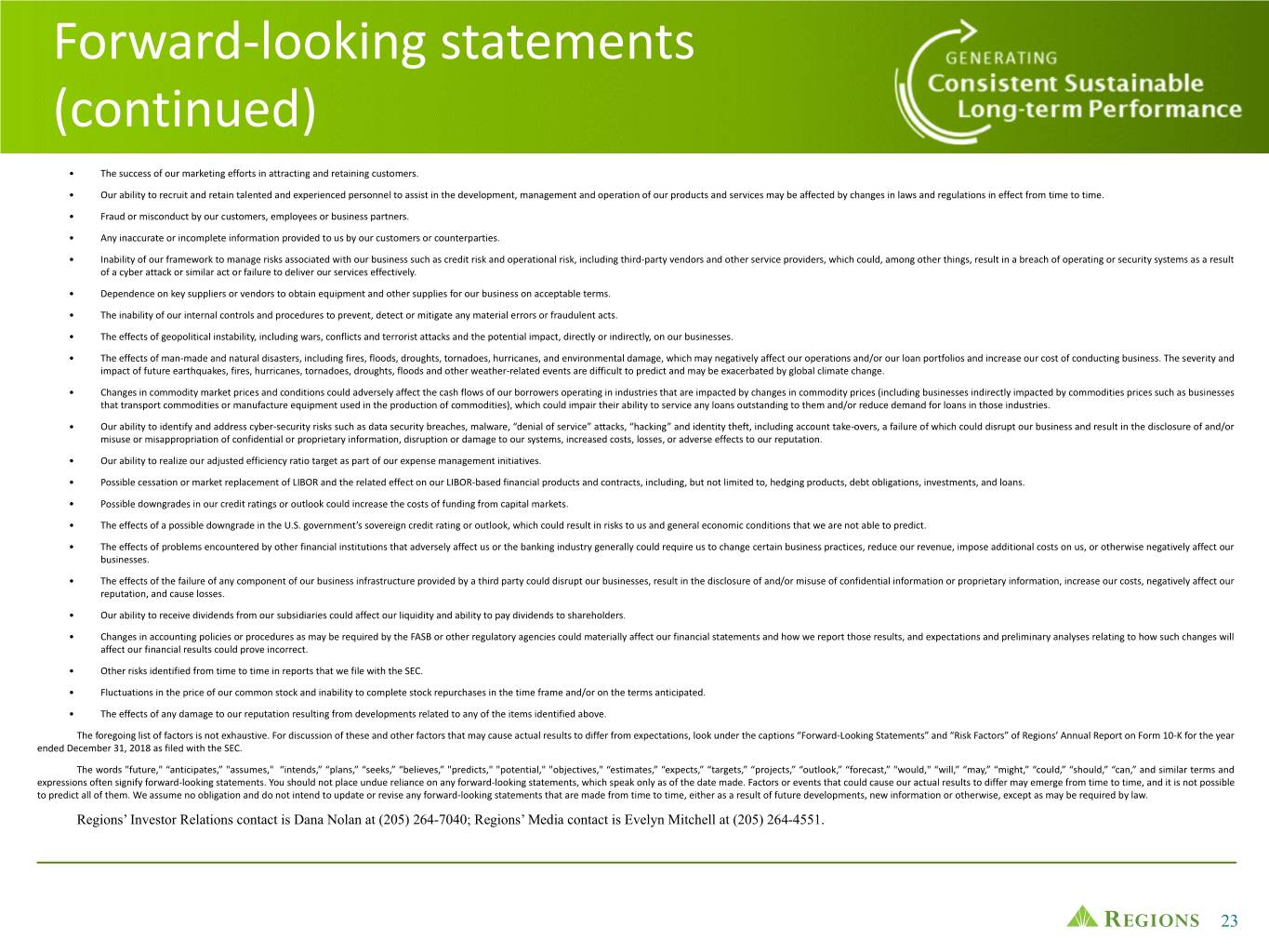
Forward-looking statements (continued) • The success of our marketing efforts in attracting and retaining customers. • Our ability to recruit and retain talented and experienced personnel to assist in the development, management and operation of our products and services may be affected by changes in laws and regulations in effect from time to time. • Fraud or misconduct by our customers, employees or business partners. • Any inaccurate or incomplete information provided to us by our customers or counterparties. • Inability of our framework to manage risks associated with our business such as credit risk and operational risk, including third-party vendors and other service providers, which could, among other things, result in a breach of operating or security systems as a result of a cyber attack or similar act or failure to deliver our services effectively. • Dependence on key suppliers or vendors to obtain equipment and other supplies for our business on acceptable terms. • The inability of our internal controls and procedures to prevent, detect or mitigate any material errors or fraudulent acts. • The effects of geopolitical instability, including wars, conflicts and terrorist attacks and the potential impact, directly or indirectly, on our businesses. • The effects of man-made and natural disasters, including fires, floods, droughts, tornadoes, hurricanes, and environmental damage, which may negatively affect our operations and/or our loan portfolios and increase our cost of conducting business. The severity and impact of future earthquakes, fires, hurricanes, tornadoes, droughts, floods and other weather-related events are difficult to predict and may be exacerbated by global climate change. • Changes in commodity market prices and conditions could adversely affect the cash flows of our borrowers operating in industries that are impacted by changes in commodity prices (including businesses indirectly impacted by commodities prices such as businesses that transport commodities or manufacture equipment used in the production of commodities), which could impair their ability to service any loans outstanding to them and/or reduce demand for loans in those industries. • Our ability to identify and address cyber-security risks such as data security breaches, malware, “denial of service” attacks, “hacking” and identity theft, including account take-overs, a failure of which could disrupt our business and result in the disclosure of and/or misuse or misappropriation of confidential or proprietary information, disruption or damage to our systems, increased costs, losses, or adverse effects to our reputation. • Our ability to realize our adjusted efficiency ratio target as part of our expense management initiatives. • Possible cessation or market replacement of LIBOR and the related effect on our LIBOR-based financial products and contracts, including, but not limited to, hedging products, debt obligations, investments, and loans. • Possible downgrades in our credit ratings or outlook could increase the costs of funding from capital markets. • The effects of a possible downgrade in the U.S. government’s sovereign credit rating or outlook, which could result in risks to us and general economic conditions that we are not able to predict. • The effects of problems encountered by other financial institutions that adversely affect us or the banking industry generally could require us to change certain business practices, reduce our revenue, impose additional costs on us, or otherwise negatively affect our businesses. • The effects of the failure of any component of our business infrastructure provided by a third party could disrupt our businesses, result in the disclosure of and/or misuse of confidential information or proprietary information, increase our costs, negatively affect our reputation, and cause losses. • Our ability to receive dividends from our subsidiaries could affect our liquidity and ability to pay dividends to shareholders. • Changes in accounting policies or procedures as may be required by the FASB or other regulatory agencies could materially affect our financial statements and how we report those results, and expectations and preliminary analyses relating to how such changes will affect our financial results could prove incorrect. • Other risks identified from time to time in reports that we file with the SEC. • Fluctuations in the price of our common stock and inability to complete stock repurchases in the time frame and/or on the terms anticipated. • The effects of any damage to our reputation resulting from developments related to any of the items identified above. The foregoing list of factors is not exhaustive. For discussion of these and other factors that may cause actual results to differ from expectations, look under the captions “Forward-Looking Statements” and “Risk Factors” of Regions’ Annual Report on Form 10-K for the year ended December 31, 2018 as filed with the SEC. The words "future," “anticipates,” "assumes," “intends,” “plans,” “seeks,” “believes,” "predicts," "potential," "objectives," “estimates,” “expects,” “targets,” “projects,” “outlook,” “forecast,” "would," “will,” “may,” “might,” “could,” “should,” “can,” and similar terms and expressions often signify forward-looking statements. You should not place undue reliance on any forward-looking statements, which speak only as of the date made. Factors or events that could cause our actual results to differ may emerge from time to time, and it is not possible to predict all of them. We assume no obligation and do not intend to update or revise any forward-looking statements that are made from time to time, either as a result of future developments, new information or otherwise, except as may be required by law. Regions’ Investor Relations contact is Dana Nolan at (205) 264-7040; Regions’ Media contact is Evelyn Mitchell at (205) 264-4551. 23
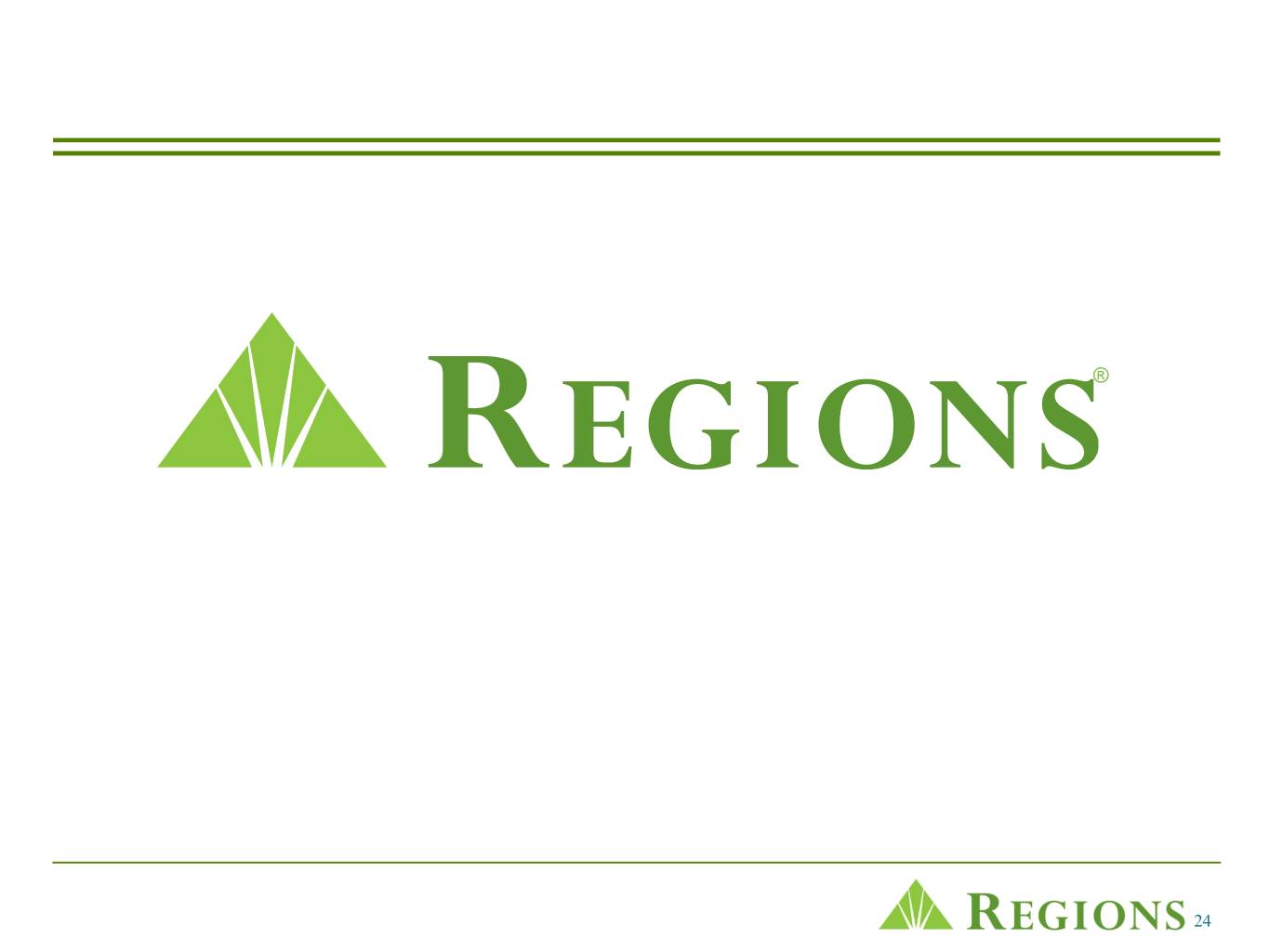
® 24























